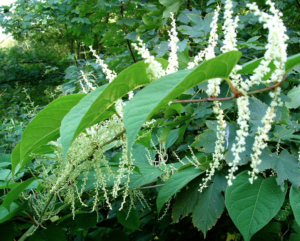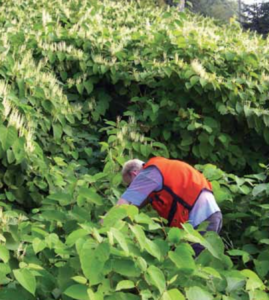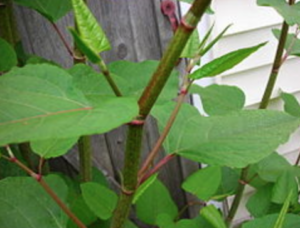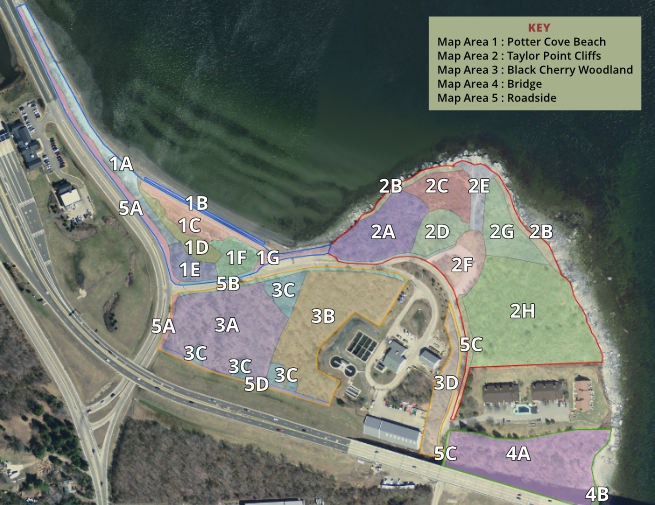Common Name: Japanese Knotweed
Specific Name: Fallopia japonica (Polygonum cuspidatum)
Known Occurrence at Taylor Point:
Map areas: Bridge 4B
Category: Invasive, Non-Native, Herbaceous Plant

Ecological Considerations:
Fallopia japonica is an herbaceous shrub that can grow from 3 to10 feet in height. It has an extensive network of rhizomes that may extend laterally up to 65 ft. The stem is smooth, stout, and swollen at joints where the leaf meets the stem. It resembles the hollow stalks of bamboo. Its leaves are broadly oval to somewhat triangular and pointed at the tip. They grow up to 6 in long and 5 in wide.
Knotweed has numerous, small, creamy white flowers arranged near the end of the plant’s arching stems. They bloom in August and September. The flowers are followed by very small winged fruits. Its seeds are triangular, dark and glossy.
Japanese knotweed grows best in full sun but is shade tolerant. Japanese knotweed can tolerate high temperatures, high salinity, and drought.
Problems Posed by this Plant:
Roadside maintenance equipment appears to disperse cut fragments of knotweed along roadways that contribute significantly to the spread of knotweed. Dumping of landscape waste also is a source of new populations. Japanese knotweed forms monocultures that reduce plant species diversity by shading native vegetation. Its rhizomes and shoots can penetrate asphalt and create cracks in concrete.
Native Species Affected by this Plant:
Factors Affording a Competitive Advantage to this Plant:
Light limitation, alteration in nutrient cycling and allelopathy (the ability to suppress growth of a potential plant competitor by releasing toxic or inhibiting chemicals) contribute to its ability to exclude native species.
Propagation Mechanisms and Related Issues Affecting Efforts to Remove and/or Eliminate this Plant from Taylor Point:
In older plants knotweed’s extensive systems of thick underground rhizomes account for as much as two thirds of the plant’s biomass. Rhizomes can reach 3 in diameter and penetrate at least 7 ft in suitable soils. Knotweed spreads vegetatively by these rhizomes and also sprouts from fragments of root and stem material.
Knotweed seedlings generally do not survive under the canopy of their parent plant and appear most likely to establish on bare soil.
Documented Best Removal Practices and Options/Pros and Cons of Various Options:
Cut knotweed back throughout the growing season. At first, this control can be accomplished with loppers or garden shears. After several seasons, the plants will be less robust and the stalks will be thinner. When the plants are smaller, it will be easier to cut them back with a scythe or grass whip. (Suzanne Enser, TPRA CRMC Permit Request Paper )
Some managers contend that cutting or mowing Japanese knotweed is not advisable because stem fragments frequently root at the nodes and generate new plants. If plants are cut, all plant parts should be removed from the site and destroyed.
Cut stem application of chemicals have been suggested for use in areas where plants are established within or around non-target plants or where vines have grown into the canopy. This treatment may remain effective at low temperatures as long as the ground is not frozen.
Foliar application is sometimes used to control large populations. It may be necessary to precede foliar applications with stump treatments to reduce the risk of damaging non-target species. Spraying late in September or October after flowering is recommended.
Control efforts must target knotweed’s massive underground system of rhizomes. Mechanical methods alone may not effectively control large Japanese knotweed populations and in fact, may make them worse. A combination of chemical and mechanical techniques, in conjunction with on-going monitoring, provides one approach to control of this species. Knotweed rhizomes may send up new shoots as many as three years later.
Due to extensive root systems, hand pulling the species is not an effective control method.
Cutting or mowing Japanese knotweed is not recommended because stem fragments frequently root at the nodes and generate new plants. If cut, all plant parts should be destroyed.
Case Studies of Removal Efforts, Lessons Learned and Recommendations:
Additional Photos:



Sources cited:
Michigan DNR
URI Department of Environment and Natural Sciences
Invasive Plant Atas
Alaska natural Heritage Program
Suzanne Enser, TPRA CRMC Permit Request Paper
Key Words:
Herbaceous Shrub;
Japanese Knotweed
Fallopia japonica
Polygonum cuspidatum
Vegetative – rhizomes;
Vegetative – root sprouting, stem sprouting;
